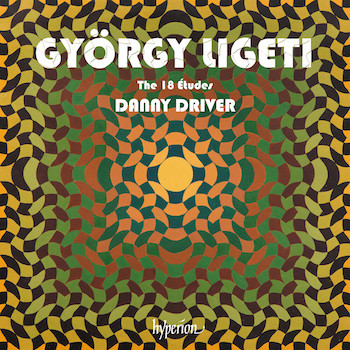Classical CD Review: György Ligeti’s “Études” — Well Played and Clearly Lived In
By Jonathan Blumhofer
Throughout these Études, Driver’s playing marries tonal warmth with textural precision.
 Few sets of keyboard pieces from the last century have proven more memorable — or aged nearly so well — as György Ligeti’s three books of piano Études. Written between 1985 and 2001, the Études hail firmly from the visionary Hungarian composer’s “late period,” in which his myriad interests, from chaos theory and fractal geometry to ethnomusicology and Renaissance polyphony, combined in stunning fashion. They are also phenomenally difficult pieces to play (Ligeti’s writing in the 18 Études pushes pianistic technique to its outermost limits) and require a musician of extraordinary stamina and insight to manage — let alone make sense of — their complexities.
Few sets of keyboard pieces from the last century have proven more memorable — or aged nearly so well — as György Ligeti’s three books of piano Études. Written between 1985 and 2001, the Études hail firmly from the visionary Hungarian composer’s “late period,” in which his myriad interests, from chaos theory and fractal geometry to ethnomusicology and Renaissance polyphony, combined in stunning fashion. They are also phenomenally difficult pieces to play (Ligeti’s writing in the 18 Études pushes pianistic technique to its outermost limits) and require a musician of extraordinary stamina and insight to manage — let alone make sense of — their complexities.
Fortunately, Danny Driver is just such a pianist. Driver first came to my attention a couple of years ago via a stupendous account of Amy Beach’s Piano Concerto. It turns out that many of the qualities that defined his Beach — a shapely definition of the musical line, carefully balanced textures, a keen ear for phrasing — serve Ligeti well, too. Who’d have guessed?
Throughout these Études, Driver’s playing marries tonal warmth with textural precision. In Book 1, “Désordre’s” pummeling rhythms and bright colors drive brilliantly. “Cordes à vide” is beautifully weighted, its lyrical lines floating serenely, while “Touches bloquées” gambols with jazzy spunk and “Arc-en-ciel” is flawlessly shaped.
Driver’s sense of the music’s character is unerringly on-point, too. The runs in Book 2’s “Der Zauberlehrling” are tight and precise — like little licks of flame spouting out of a campfire and disappearing into the twilight. Likewise, there’s an astonishingly free and easy-going feel to his playing in “Entrelacs,” its blizzard of notes keenly balanced yet constantly dancing. Meanwhile, “L’escalier du diable” and “Coloana infinita” surge.
The situation is much the same in Book 3. Driver ably draws out the textural and melodic contrasts in “White on White” and articulates the metric modulations in “Pour Irina” with playful clarity. “À bout de souffle” lunges maniacally, while his rhythmically precise take on the “Canon” makes for a fittingly enigmatic closing statement.
Overall, Driver’s accounts of these Études are very well played and clearly lived in. His tempos are sometimes broader than Pierre-Laurent Aimard’s and Frederic Ullén’s in this same repertoire, but Driver’s musicality carries the day. There’s lots of energy to be had throughout and, often enough, he draws out the dancing impetus behind Ligeti’s writing. Taken with the bracing clarity of the musical line, the disc’s excellent recorded sound, and an informative, personalized booklet note by the pianist, Driver’s is a welcome, distinctive addition to the Ligeti Étude discography.
Jonathan Blumhofer is a composer and violist who has been active in the greater Boston area since 2004. His music has received numerous awards and been performed by various ensembles, including the American Composers Orchestra, Kiev Philharmonic, Camerata Chicago, Xanthos Ensemble, and Juventas New Music Group. Since receiving his doctorate from Boston University in 2010, Jon has taught at Clark University, Worcester Polytechnic Institute, and online for the University of Phoenix, in addition to writing music criticism for the Worcester Telegram & Gazette.

[…] Read More from artsfuse.org […]
[…] Classical CD Review: György Ligeti’s “Études” — Well Played and Clearly Lived In https://artsfuse.org/226403/classical-cd-review-gyorgy-ligetis-etudes-well-played-and-clearly-lived-… […]